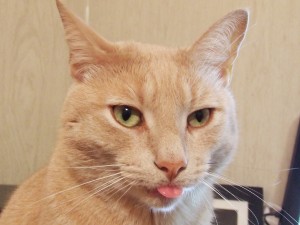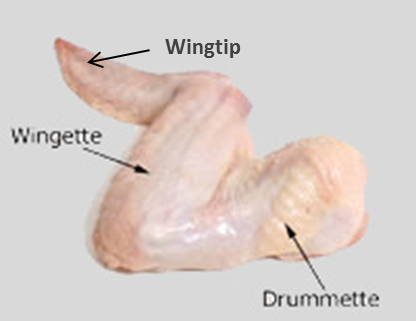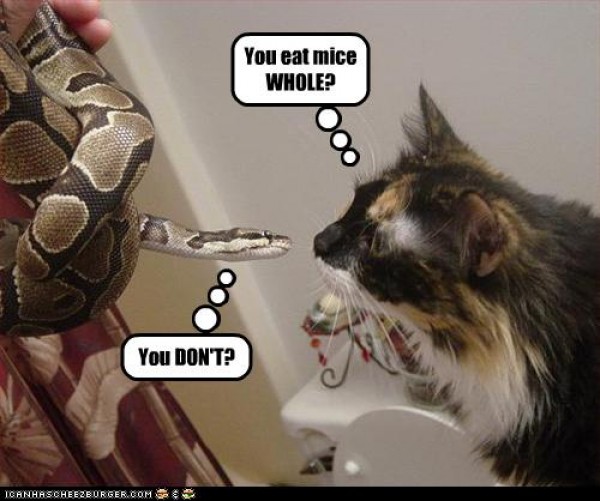Written by Tracy Dion, March 2012
 Since its arrival in the US in the 1930’s, the pet food industry has been extraordinarily successful in their marketing campaigns, managing to convince an entire generation that they are inherently incapable of feeding their pets without “expert” guidance, and erasing over 10,000 years of evolutionary fact; to whit, cats are obligate carnivores that thrive on a raw meat, prey-based diet. Today, home-feeding raw meat, bones and organs is considered a novel and dangerous concept.
Since its arrival in the US in the 1930’s, the pet food industry has been extraordinarily successful in their marketing campaigns, managing to convince an entire generation that they are inherently incapable of feeding their pets without “expert” guidance, and erasing over 10,000 years of evolutionary fact; to whit, cats are obligate carnivores that thrive on a raw meat, prey-based diet. Today, home-feeding raw meat, bones and organs is considered a novel and dangerous concept.
The truth, of course, is that anyone putting a little thought and time into it can home-feed a cat; it’s neither mind-boggling nor formidable.
To help you get started home-feeding your kitty, here are several prey model raw, or, as it’s affectionately known, “frankenprey” feeding tips (for more extensive information, see ‘A Prey Model Raw (PMR) / Whole Prey Feeding Guide’).
On Meat
The best way to introduce a cat to meat is to cut it in long strips no wider than your pinkie finger. This is small enough for the cat to fit one end in his mouth, but will force him to use his side teeth to scissor off bite-sized pieces, shortening his learning curve and helping to strengthen jaw muscles atrophied from years of eating crumbly kibbles and canned mush.
Chicken and pork are great starter meats, as they are fairly soft and easy to chew. And on the topic of pork, you are likely going to hear comments indicating that many cats don’t like pork or beef, or are “allergic” to them. First, every cat is different and you never know what your cat will like until you try him. Second, cats change their minds all the time; if you keep offering variety, they will eventually accept and adjust to it. And variety is very important.
Third, true feline protein allergies are exceedingly rare. Almost invariably, if a cat throws up a particular food, it’s due to other reasons. Some of the most common are: the food was too cold, the cat ate it too fast or swallowed too large a chunk for proper digestion, and – if the cat has gone too long without eating – he’s regurgitating it due to the high acid content in his stomach. In every one of these scenarios, the cat can usually re-eat the food and keep it down without issue.
Another common reason for regurgitating or vomiting raw home-prepared foods is the presence of flavor “enhancers” in the meat. *Always* read the labels before you buy, even if it’s an item you regularly purchase. Look for words like injected, added flavor, and more tender or juicier; all of them likely indicate that some type of seasoning has been added to the meat. Cats that don’t hork these products up may suffer from hot spots or itchy skin, rashes, loose stools, or increased thirst, so it’s important to avoid them.
Note: If you can’t tell whether the meat has been enhanced or not, look at the “per serving” numbers. Products with less than 100 mg of sodium per serving are probably free of these additives.
On Bones
If you’ve done any research into this topic, you’ve likely already come across the canine raw feeding 80/10/5/5 guideline. The cat’s is similar, 83/7/5/5, just modified slightly to account for the lighter-boned prey. That breaks down to 83% meat, fat, skin, sinew, connective tissue and heart, 7% edible bone, 5% liver, and 5% other secreting organ. Calculating how much to feed daily – that would be 2-4% of your cat’s weight – is easy enough, and multiplying that by .83 or .05 for the meat and organ percentages is also easy, but trying to figure out 7% edible bone when bones are purchased and must be fed wrapped in meat is not. This is, in fact, one of the most common questions from neophyte raw-feeders.
My response? Don’t bother trying to ascertain the specific calculations. That 7%  is the average bone content of several of the cat’s natural prey animals and no matter where a cat’s comfort zone lies (exactly at 7%, or a little above or below it), too little will cause loose stools and too much will cause increasingly hard stools. The average cat finds three staggered bone-in meals a week (i.e. Monday night, Wednesday night and Friday night) perfectly acceptable, and for most, the wing-tip and center portions of a single medium-sized chicken wing make a nicely proportioned meal (and the drummette, deboned, makes a great all-meat meal).
is the average bone content of several of the cat’s natural prey animals and no matter where a cat’s comfort zone lies (exactly at 7%, or a little above or below it), too little will cause loose stools and too much will cause increasingly hard stools. The average cat finds three staggered bone-in meals a week (i.e. Monday night, Wednesday night and Friday night) perfectly acceptable, and for most, the wing-tip and center portions of a single medium-sized chicken wing make a nicely proportioned meal (and the drummette, deboned, makes a great all-meat meal).
Note: All of these comments reflect a menu that consists of three meals a day. Unlike dogs, cats evolved to eat many discrete, small meals over a 24-hour period, and they shouldn’t be fed any less than three times a day.
So start there! For a couple of weeks, feed your cat bone-in meals consisting of the tips and wingettes of chicken wings. Get used to estimating how much bone that is, and watch the litter box – if your cat’s stools stay firm but moist, you know he’s eating an acceptable amount of bone. If they become soft, you can add a wee bit more bone (unless you’re feeding a lot of fat or organs, and we’ll talk about that in a minute) and if they become too hard or dry, you need to cut back on the amount just a bit.
Note: If your cat is new to bone or has trouble with the wings, cut the tips off at the joint, and cut the wingettes in half lengthwise, parallel to and in between the two bones. If he still has trouble, you can break the bones for him, but try not to break the skin, as you want him to learn to eat these on his own.
After that two week period, you should have a good grasp of how much bone your cat needs and can start swapping the chicken wings for other bone-in meals. Variety is important, so try to source at least one or two other types of bone-in products, like chicken and rabbit ribs with meat, and small rabbit bones.
On Organs
There are two organ requirements in a frankenprey diet. The first is liver and the second is any other secreting organ from the body of an animal – pancreas, testicles, thyroid glands, and kidney are all great options. If you can alternate between them, so much the better. You can source these products from any animal, but poultry and rabbit organs seem to be better tolerated.
Note: From a raw-feeding perspective, lungs, gizzards and heart are considered muscle meats and do not count as part of the organ percentage.
Organs contain enzymes – one of their primary benefits – and are often strongly flavored. A cat that is not accustomed to eating organs may become nauseous if fed too much at one time. Even many experienced cats can’t handle more than an ounce at once (think of how tiny are the organs inside a mouse or a bird!). For this reason, don’t feed an entire week’s worth of organs in a single meal and don’t make an entire meal out of organs – your cat is almost guaranteed to throw it right back up if you do. Instead, spread the week’s organs out over several meals and make each meal half organ and half meat.
In addition to nausea and vomiting, too much organ can cause loose stools. As you are working to transition your cat onto a frankenprey diet, work first with meats, then get the bone-in meals adjusted, then add in the organs. It is not harmful for your cat to eat an organ-free diet for a few weeks (a few weeks only!).
On Fat and Skin
Cats are constrained by their physiology to sourcing all of their energy, growth and maintenance needs through the calories found in meat-based proteins and fat. They cannot properly utilize the calories from carbs (these are simply turned into body fat) and, in fact, if they do not get enough calories through meat-based protein and fat, they will sabotage their own bodies for what they need, irrespective of how many plant-based calories they may also be eating. (This is the underlying reason so many older and kidney-compromised cats lose muscle mass.)
Obviously, then, a cat’s need for protein and fat is higher than human or canine requirements. Any cat eating a meat-based 83/7/5/5 diet is going to get its protein needs satisfied. Fat, on the other hand, needs to be monitored.
Skin is a good source of fat, so try to leave it on whenever possible. Chicken products are also often high in fat, so including them on your cat’s menu several times a week is a good idea. Rabbit is usually a very lean animal, so it should never be the bulk of a cat’s diet. Unless the fat is very thick, hard or chunky, it can usually be left alone in pork and beef products.
Of course – as with any excess – too much fat in a single meal has consequences, and these usually arrive in the form of nausea and / or loose stools. For this reason, it’s usually best to pull the thicker skin off chicken breasts, thighs and quarters.
Keep A Journal And Create A Schedule
Keeping a journal might take a bit of your time, but the ROI is high. You will come to understand your cat and his needs quicker, and you will be able to spot potential trouble sooner. Without a journal, for instance, I may not have realized my lovely Rachel had regurgitated several of her first few beef meals because she absolutely loves beef and was so eager to eat, she was swallowing whole chunks. Once I started cutting her beef in smaller pieces, the regurgitation stopped, and I was able to slowly work her back up to whole ounce chunks.
Likewise, a feeding schedule might take a bit of work initially, but once created and posted somewhere easily accessible, it relieves you of the need to wonder on any given morning what you should be feeding that day. I sometimes hear raw feeders proclaiming that feeding raw is so simple they just throw down a little of this and a little of that, and I find myself concerned on their behalf – raw feeding is a simple concept, but it cannot be haphazard in practice. Balance is vital to maintain health.
So work up a schedule (you can see mine here) for stress- and error-free balanced feeding.
Don’t Stress It!
And speaking of stress…. don’t! You are not in a race and there is no time limit on a transition. This is a lifestyle change for you and for your cat and it must be done at the cat’s pace. Some will take to raw after a single meal, others may take weeks. However long it takes your cat, don’t force, don’t hover, and don’t stress about it.
Cats are very sensitive creatures and pick up distress quite easily. If you are hovering over them, shedding anxiety and begging them to just eat one bite (and I have counseled owners who have done just this), your cat is more likely to want to hide from the obviously impeding “awful event” than he will be to eat.
So relax! Take it at your kitty’s pace and enjoy each step as he learns to eat the way nature intended for him. You will be better able to manage and even enjoy his progress. I have spoken with many owners who exclaimed that after cringing during the first few bone-in meals, the sound of their cat chomping through bone now gives them a curious sense of satisfaction; and so it will be with you!
In conclusion, I leave you with this thought, courtesy of LOLCats.
If you enjoyed this article or found it informative, please “Like” it, “Tweet” it, or share it using any of the buttons below. And don’t forget to check out our FB page, join the discussions in our awesome FB group and follow us on Twitter!
Created 03/26/12; Updated 9/18/17


